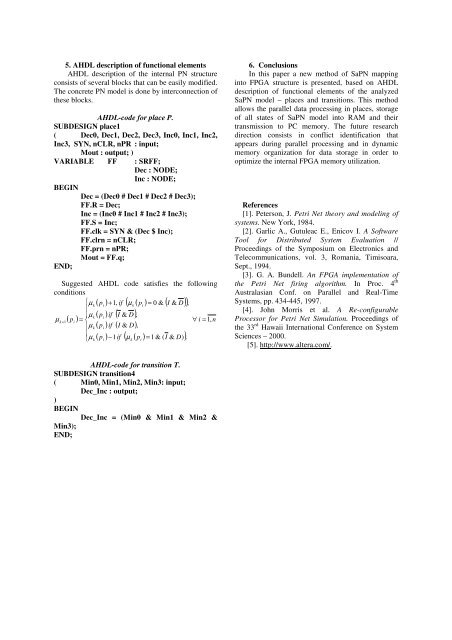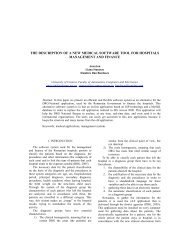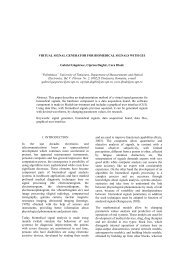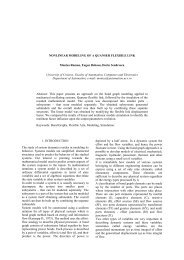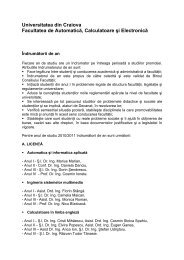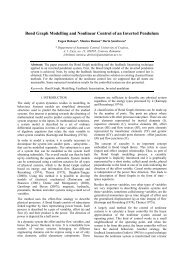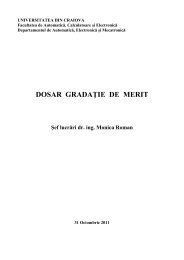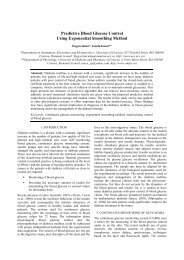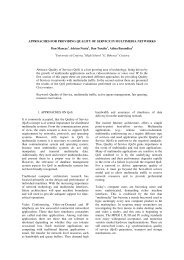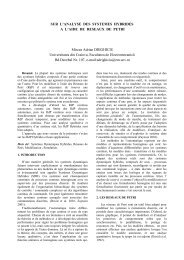Technical University of Moldova avv@mail.utm.md
Technical University of Moldova avv@mail.utm.md
Technical University of Moldova avv@mail.utm.md
You also want an ePaper? Increase the reach of your titles
YUMPU automatically turns print PDFs into web optimized ePapers that Google loves.
5. AHDL description <strong>of</strong> functional elements<br />
AHDL description <strong>of</strong> the internal PN structure<br />
consists <strong>of</strong> several blocks that can be easily modified.<br />
The concrete PN model is done by interconnection <strong>of</strong><br />
these blocks.<br />
AHDL-code for place P.<br />
SUBDESIGN place1<br />
( Dec0, Dec1, Dec2, Dec3, Inc0, Inc1, Inc2,<br />
Inc3, SYN, nCLR, nPR : input;<br />
Mout : output; )<br />
VARIABLE FF : SRFF;<br />
Dec : NODE;<br />
Inc : NODE;<br />
BEGIN<br />
Dec = (Dec0 # Dec1 # Dec2 # Dec3);<br />
FF.R = Dec;<br />
Inc = (Inc0 # Inc1 # Inc2 # Inc3);<br />
FF.S = Inc;<br />
FF.clk = SYN & (Dec $ Inc);<br />
FF.clrn = nCLR;<br />
FF.prn = nPR;<br />
Mout = FF.q;<br />
END;<br />
Suggested AHDL code satisfies the following<br />
conditions<br />
⎧µ<br />
k<br />
( pi<br />
) + 1, if ( µ<br />
k<br />
( pi<br />
) = 0 & ( I & D<br />
),<br />
⎪<br />
⎪µ<br />
k<br />
( pi<br />
) if ( I & D)<br />
,<br />
µ<br />
k + 1<br />
( pi<br />
) = ⎨<br />
∀ i = 1,<br />
n<br />
⎪µ<br />
k<br />
( pi<br />
) if ( I & D)<br />
,<br />
⎪<br />
⎩µ<br />
k<br />
( pi<br />
) −1if<br />
( µ<br />
k<br />
( pi<br />
) = 1 & ( I & D)<br />
).<br />
6. Conclusions<br />
In this paper a new method <strong>of</strong> SaPN mapping<br />
into FPGA structure is presented, based on AHDL<br />
description <strong>of</strong> functional elements <strong>of</strong> the analyzed<br />
SaPN model – places and transitions. This method<br />
allows the parallel data processing in places, storage<br />
<strong>of</strong> all states <strong>of</strong> SaPN model into RAM and their<br />
transmission to PC memory. The future research<br />
direction consists in conflict identification that<br />
appears during parallel processing and in dynamic<br />
memory organization for data storage in order to<br />
optimize the internal FPGA memory utilization.<br />
References<br />
[1]. Peterson, J. Petri Net theory and modeling <strong>of</strong><br />
systems. New York, 1984.<br />
[2]. Garlic A., Gutuleac E., Enicov I. A S<strong>of</strong>tware<br />
Tool for Distributed System Evaluation //<br />
Proceedings <strong>of</strong> the Symposium on Electronics and<br />
Telecommunications, vol. 3, Romania, Timisoara,<br />
Sept., 1994.<br />
[3]. G. A. Bundell. An FPGA implementation <strong>of</strong><br />
the Petri Net firing algorithm. In Proc. 4 th<br />
Australasian Conf. on Parallel and Real-Time<br />
Systems, pp. 434-445, 1997.<br />
[4]. John Morris et al. A Re-configurable<br />
Processor for Petri Net Simulation. Proceedings <strong>of</strong><br />
the 33 rd Hawaii International Conference on System<br />
Sciences – 2000.<br />
[5]. http://www.altera.com/.<br />
AHDL-code for transition T.<br />
SUBDESIGN transition4<br />
( Min0, Min1, Min2, Min3 : input;<br />
Dec_Inc : output;<br />
)<br />
BEGIN<br />
Dec_Inc = (Min0 & Min1 & Min2 &<br />
Min3);<br />
END;


